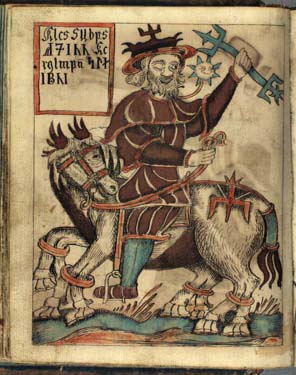Near-death experiences are a bitch. I had one in 1998, and since then I've been going through life with an "Oooh, shiny!" attitude. It's hard to describe what matters; hard to get stuff done.
I remember when the proto-internet (with Usenet News, teletypes, mainframes), as a source of information, was entirely accessible. Now every day there is more than a lifetime's worth of new stuff on it. All shiny.
Monday, June 24, 2013
Friday, June 14, 2013
Five ways to make a Sleipnir in real life, and two ways not to make a Sleipnir: Method One.
In Norse mythology, Sleipnir is Odin's eight-legged horse. Odin is king of the gods, the All-father; his grey horse Sleipnir is considered "the best of horses." To the delight of the Tumblrati, the Norse deity Loki, usually considered male, is Sleipnir's mother.
Many people are interested in depicting Sleipnir, in two dimensional images or in three-dimensional models. There are Viking-age images in stones.

(This is from the Tjängvide image stone, from Gotland, Sweden; image is from Wikipedia, https://en.wikipedia.org/wiki/File:Ardre_Odin_Sleipnir.jpg)
There are also later Icelandic manuscript images, such as this one from 1760 or so.

(From Ólafur Brynjúlfsson's manuscript in the Danish Royal Library, http://www.kb.dk/permalink/2006/manus/738/dan/97+verso/?var=)
Since the time of the Norse, though, we have learned a lot about genetics. Would it be possible to have an actual, breathing, eight-legged horse? If so, what would be the biology of such a marvel? Here are some possibilities.
1. Grafting. Take two horse embryos, slice them together as segments, to give two segments each with front legs and rear legs. This would give you a horse with the look of the Tjängvide image.

(from the California Digital Newspaper Collection, http://cbsrimage.ucr.edu/cgi-bin/cdnc?a=d&d=SFC18980206.2.150.17#)
In model horses, Leah Koerper of Shoestring Stables has made a lovely Sleipnir this way. See her webpages, http://shoestringstable.wordpress.com/tag/fantasy/ and http://shoestringstable.wordpress.com/tag/sleipnir/http://shoestringstable.wordpress.com/tag/sleipnir/; I will not reproduce her art here; please visit her site.
So what are the problems with this approach? In real life, this technique works on insects, but not fish, birds, mammals, etc. The hard structure of insects are on the outside, and especially during metamorphosis (when the insects in this study were sliced and stacked like sandwich ingredients) the interior is mainly disorganized. Nevertheless, many internal organs of the insects did not fuse across segment boundaries.(See the article on Regeneration in The New International Encyclopaedia, Vol. 19, 1918; which is available as on Google Books: http://books.google.com/books?id=O28NAQAAMAAJ&pg=PA654&lpg=PA654#v=onepage&q&f=false).
Getting internal features to match-up for horses would be even more difficult. With two chest sections, a Sleipnir-horse built this way would have two hearts for extra power; but how would the circulatory systems hook up? Even worse, it would have two colons, but only one anus; the dead-end gut would lead to colic, or worse. One would need far more tinkering than section-slicing for this approach to be successful in real life.
Next: genetic repurposing.
Many people are interested in depicting Sleipnir, in two dimensional images or in three-dimensional models. There are Viking-age images in stones.

(This is from the Tjängvide image stone, from Gotland, Sweden; image is from Wikipedia, https://en.wikipedia.org/wiki/File:Ardre_Odin_Sleipnir.jpg)
There are also later Icelandic manuscript images, such as this one from 1760 or so.

(From Ólafur Brynjúlfsson's manuscript in the Danish Royal Library, http://www.kb.dk/permalink/2006/manus/738/dan/97+verso/?var=)
Since the time of the Norse, though, we have learned a lot about genetics. Would it be possible to have an actual, breathing, eight-legged horse? If so, what would be the biology of such a marvel? Here are some possibilities.
1. Grafting. Take two horse embryos, slice them together as segments, to give two segments each with front legs and rear legs. This would give you a horse with the look of the Tjängvide image.
Such experiments have actually been performed for planaria (flatworms), and for animals as complex as insects. In the 1890's, a biologist named Henry Crompton sliced together segments of silkmoth pupa which developed into intersex moths and moths with multiple wings.The segments were glued together with paraffin wax. Some of his experimental results are shown in this page from the San Francisco Call (Volume 83, Number 66, 6 February 1898):
(from the California Digital Newspaper Collection, http://cbsrimage.ucr.edu/cgi-bin/cdnc?a=d&d=SFC18980206.2.150.17#)
In model horses, Leah Koerper of Shoestring Stables has made a lovely Sleipnir this way. See her webpages, http://shoestringstable.wordpress.com/tag/fantasy/ and http://shoestringstable.wordpress.com/tag/sleipnir/http://shoestringstable.wordpress.com/tag/sleipnir/; I will not reproduce her art here; please visit her site.
So what are the problems with this approach? In real life, this technique works on insects, but not fish, birds, mammals, etc. The hard structure of insects are on the outside, and especially during metamorphosis (when the insects in this study were sliced and stacked like sandwich ingredients) the interior is mainly disorganized. Nevertheless, many internal organs of the insects did not fuse across segment boundaries.(See the article on Regeneration in The New International Encyclopaedia, Vol. 19, 1918; which is available as on Google Books: http://books.google.com/books?id=O28NAQAAMAAJ&pg=PA654&lpg=PA654#v=onepage&q&f=false).
Getting internal features to match-up for horses would be even more difficult. With two chest sections, a Sleipnir-horse built this way would have two hearts for extra power; but how would the circulatory systems hook up? Even worse, it would have two colons, but only one anus; the dead-end gut would lead to colic, or worse. One would need far more tinkering than section-slicing for this approach to be successful in real life.
Next: genetic repurposing.
Subscribe to:
Posts (Atom)